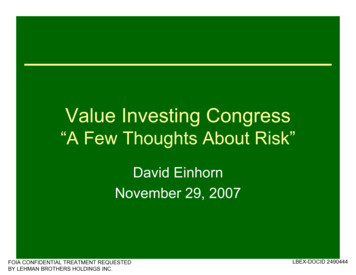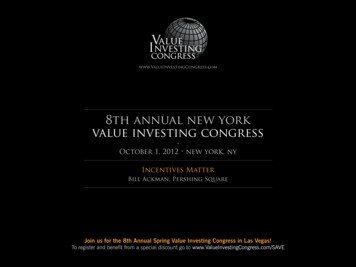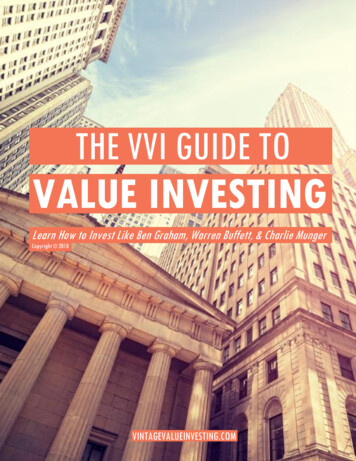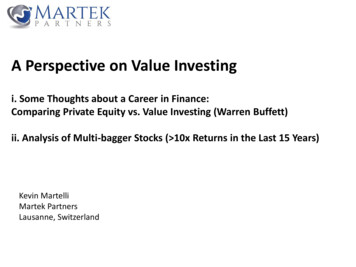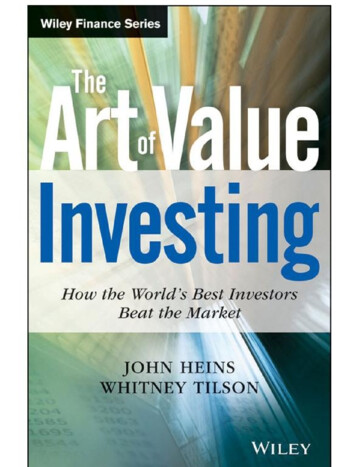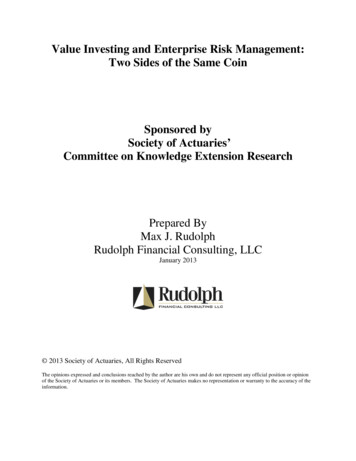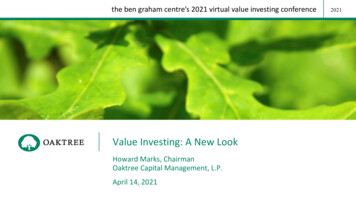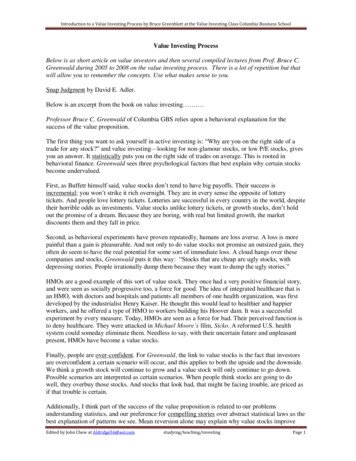
Transcription
Introduction to a Value Investing Process by Bruce Greenblatt at the Value Investing Class Columbia Business SchoolValue Investing ProcessBelow is as short article on value investors and then several compiled lectures from Prof. Bruce C.Greenwald during 2005 to 2008 on the value investing process. There is a lot of repetition but thatwill allow you to remember the concepts. Use what makes sense to you.Snap Judgment by David E. Adler.Below is an excerpt from the book on value investing .Professor Bruce C. Greenwald of Columbia GBS relies upon a behavioral explanation for thesuccess of the value proposition.The first thing you want to ask yourself in active investing is: ―Why are you on the right side of atrade for any stock?‖ and value investing—looking for non-glamour stocks, or low P/E stocks, givesyou an answer. It statistically puts you on the right side of trades on average. This is rooted inbehavioral finance. Greenwald sees three psychological factors that best explain why certain stocksbecome undervalued.First, as Buffett himself said, value stocks don’t tend to have big payoffs. Their success isincremental; you won’t strike it rich overnight. They are in every sense the opposite of lotterytickets. And people love lottery tickets. Lotteries are successful in every country in the world, despitetheir horrible odds as investments. Value stocks unlike lottery tickets, or growth stocks, don’t holdout the promise of a dream. Because they are boring, with real but limited growth, the marketdiscounts them and they fall in price.Second, as behavioral experiments have proven repeatedly, humans are loss averse. A loss is morepainful than a gain is pleasurable. And not only to do value stocks not promise an outsized gain, theyoften do seem to have the real potential for some sort of immediate loss. A cloud hangs over thesecompanies and stocks, Greenwald puts it this way: ―Stocks that are cheap are ugly stocks, withdepressing stories. People irrationally dump them because they want to dump the ugly stories.‖HMOs are a good example of this sort of value stock. They once had a very positive financial story,and were seen as socially progressive too, a force for good. The idea of integrated healthcare that isan HMO, with doctors and hospitals and patients all members of one health organization, was firstdeveloped by the industrialist Henry Kaiser. He thought this would lead to healthier and happierworkers, and he offered a type of HMO to workers building his Hoover dam. It was a successfulexperiment by every measure. Today, HMOs are seen as a force for bad. Their perceived function isto deny healthcare. They were attacked in Michael Moore’s film, Sicko. A reformed U.S. healthsystem could someday eliminate them. Needless to say, with their uncertain future and unpleasantpresent, HMOs have become a value stocks.Finally, people are over-confident. For Greenwald, the link to value stocks is the fact that investorsare overconfident a certain scenario will occur, and this applies to both the upside and the downside.We think a growth stock will continue to grow and a value stock will only continue to go down.Possible scenarios are interpreted as certain scenarios. When people think stocks are going to dowell, they overbuy those stocks. And stocks that look bad, that might be facing trouble, are priced asif that trouble is certain.Additionally, I think part of the success of the value proposition is related to our problemsunderstanding statistics, and our preference for compelling stories over abstract statistical laws as thebest explanation of patterns we see. Mean reversion alone may explain why value stocks improveEdited by John Chew at Aldridge56@aol.comstudying/teaching/investingPage 1
Introduction to a Value Investing Process by Bruce Greenblatt at the Value Investing Class Columbia Business Schooland growth stocks fall back to earth. This statistical story may be the whole story. But our intuitionhas problems handling this abstract explanation, and so we mentally discount the likelihood ofbelow-average stocks returning to average. We look for deeper meaning where there is none.The success of value investing has been known for many years since Graham and Dodd’s book inthe 1930s. Buffett and John Templeton’s success as value investors isn’t exactly secret. So why thenhasn’t the market arbitraged away this anomaly? Why isn’t everyone a value investor? There are,of course, lots of rational reasons. It can take a very long time for cheaply priced value stocks toreturn to fair value. As I keep emphasizing. The stock market and investing are faddish, and cyclethrough value as well as growth fazes. Although Buffett didn’t lose money because he sat out thetech bubble, it means he couldn’t make it there either, and a lot of people got very rich throughInternet stocks.Also, before you get bitten by the value bug, keep in mind that value investing usually gets killedduring severe market downturns. The success of value investing in the last decade, before the recentcrisis, was driven largely by private equity managers who scoured the market for undervaluedcompanies to snap up. If private equity becomes sidelined because of problems obtaining credit,value stocks won’t have the same solid support levels.Nonetheless, study after study proves value works. Also remember that value investing isn’t buyingstocks that merely look bad, it always means using some sort of formalized evaluation process todetermine if stocks are under priced. To become a successful value investor, you have to overcomeyour hardwired aversions and intuitions. This isn’t the story of Black Swans, anticipating someunimaginable, essentially unthinkable random event with huge consequences. Value investing ismuch easier and more predictable than that. All you have to do is find the cygnet everyone else hasignored and written off that will turn into a White Swan.Introduction to Value InvestingValue investing (―VI‖) is a rational, disciplined approach to help navigate the investment world ruledby speculation, unjust emotions, confusion and momentum. The core value is very basic: that theunderlying value of financial security is measurable and stable regardless what the market does to it.The goal is to purchase securities when their market prices differ significantly from theirfundamental value. Value investors have been forced to be a little more ingenious in their ways ofidentifying, measuring and defining value. From Warren Buffett, Walter Schloss and Mario Gabelli-the disciples of value investing are plentiful and to date no other investment method has proved to bemore successful as professor Greenwald will go into.Bruce Greenwald (“BG”):VALUE INVESTING AND A WELL-CONCEIVED INVESTMENT PROCESSWhat is a professional, well conceived investment process?But there are other approaches that are characterized by investors who have been strikinglysuccessful—there are not many of them but at least some of them are. If you do pursue thoseapproaches, you ought to have an idea that within the context of those alternatives what anappropriate system for investing looks like. The professor is referring to momentum investing,growth investing, and macro investing.Edited by John Chew at Aldridge56@aol.comstudying/teaching/investingPage 2
Introduction to a Value Investing Process by Bruce Greenblatt at the Value Investing Class Columbia Business SchoolValue InvestingNow value investing (VI) belongs to the genre of fundamental investing. It involves looking atunderlying securities. It involves buying securities at a 2/3 or ½ or less of their actual value. VI issimply buying bargains in financial markets. And having bought bargains, holding them for areasonably long period of time. Having described it that way, of course, the natural question thatmost of you who would want to ask is: What non value investing is? If you are buying thebargains, who are the people who are selling to you? And I think it would be useful to get a sense ofthat.Other Schools of InvestingApproaches to InvestingLong TermShort TermEfficient MarketsAsset calCost MinimizationMomentumPrice/Volume PatternsLevels ChangesMkt Price vs. ValueCurrent Price Forecast ChangeMicroTrue G&D Investorsare HERE.MacroRelative Value Rarely Done Well(Shliefer, Vishny, Lakonishok)First, there are a lot of short-term approaches to investing. The most common approach to short-terminvesting at least in terms of the research disseminated is what might be called short-termfundamental investing. What you do is forecast either a quarter out or a year or two years out someappropriate quantity to do with the companies’ securities that you will be buying. Most commonly,of course, that is earnings. Then you compare your forecast to the consensus either as it is apparentin surveys or as you can infer it from stock price level of that security or the bond price level of thatsecurity. And if you think your forecast is more optimistic than the implied consensus, you buy onthe theory that when the news is revealed, you turn out to be right and everyone else turns out to bewrong. The stock is going to go up, and you will make money. If the opposite is true, the morepessimistic estimate becomes apparent that you are right and everybody else is wrong the stockwill go down.But notice what has got to happen to do this successfully, you must have information that no one elsehas. The classic investor of this sort is my dentist who is a terrific dentist and a terrible investor. Hisidea of short-term information is the demographics of the US population. I guarantee you he is not anexpert in the use of that information. But that is an alternative style of investing.Edited by John Chew at Aldridge56@aol.comstudying/teaching/investingPage 3
Introduction to a Value Investing Process by Bruce Greenblatt at the Value Investing Class Columbia Business SchoolThen there is a whole large school of technical investing. It is a school where all you look at istrading patterns in the market. Momentum is the simplest of those approaches. If prices are going up,then prices will continue going up. Some people look at complicated price patterns and make shortterm price projections. If they indicate prices will be higher, they buy and vice versa. So there areplenty of alternative approaches to investment. Also, when you look at fundamentals, either you canlook at companies or at interest rates and the economy as a whole. The other dominant school ofinvesting for many years was efficient market investing. Basically the idea was that you were notgoing to be able to beat the market with information that was no better than what the consensus hadcollected.WHY VALUE INVESTING WORKSMarkets are not EfficientAll you should worry about since you aren’t going to be able to outguess the market is minimizingtransaction costs, and allocating assets that creates an appropriate risk profile. What I think youought to know about that is two things. The first is that there is overwhelming statistical evidencethat markets are not efficient. In all countries and all periods of time since the early 20th century,that there are variables that can be reliably used to outperform the market and that clearly contradictsthe premise that nobody can outperform the market. There is a sense in which absolutely andfundamentally markets are efficient and it is this—that when we buy as night follows the daysomeone else is selling that stock thinking it is going down--and one of you is always wrong. (Don’tplay the patsy!)Why Are You on the Right Side of the Trade?Another way of saying that is not everybody can outperform the market. The famous humoristcalled Garrison Keiller talks about a fictional town called Lake Woebegone. In Lake Woebegone allthe women are beautiful, all the men are tall and all the children are above average. In this game allthe children are average on average which means half of them underperforms the market. So whenyou start to think about investing, you must be able to answer the question: Why are you able to beon the right side of the particular trade? Why are you the one who is right, and the person who istrading with you is wrong? That is the most fundamental aspect of Investing. Where and what isyour investing edge? What puts you on the right side of the trade?Buying Cheaply WorksWhen we talk about value investing there is a lot of evidence that value investors have been on theright side of the trade. The statistical studies that run against or contradict market efficiency almostall of them show that cheap portfolios—low market-to-book, low price-to-book—outperform themarkets by significant amounts in all periods in all countries—that is a statistical, historical basis forbelieving that this is one of the approaches where people are predominantly on the right side of thetrade. And, of course, someone else has to be on the wrong side of the trade.Those studies were first done in the early 1930s; they were done again in the early 1950s. And theones done in the 1990s got all the attention because the academics caught on. There is statisticalevidence that the value approaches—buy cheap securities—have historically outperformed themarket. Buying Cheap works.1st Evidence: Markets are not efficient. There is overwhelming evidence for periods going back to1860, the markets are not efficient. 70% of professional investors under perform.Edited by John Chew at Aldridge56@aol.comstudying/teaching/investingPage 4
Introduction to a Value Investing Process by Bruce Greenblatt at the Value Investing Class Columbia Business SchoolThe statistical approaches using value criteria automatically beat the market by 3%-5% annually.You must do better by reducing risk or concentrating.Tweedy Brown: Stock Price as a Pct. of Book Value, 1967 - 1984 (from What Has Worked InInvesting)Deciles1 (Lowest price as % of BV)2345678910 (Highest Price as % of BVCompoundedAnnua
Value investing (―VI‖) is a rational, disciplined approach to help navigate the investment world ruled by speculation, unjust emotions, confusion and momentum. The core value is very basic: that theFile Size: 785KBPage Count: 62




